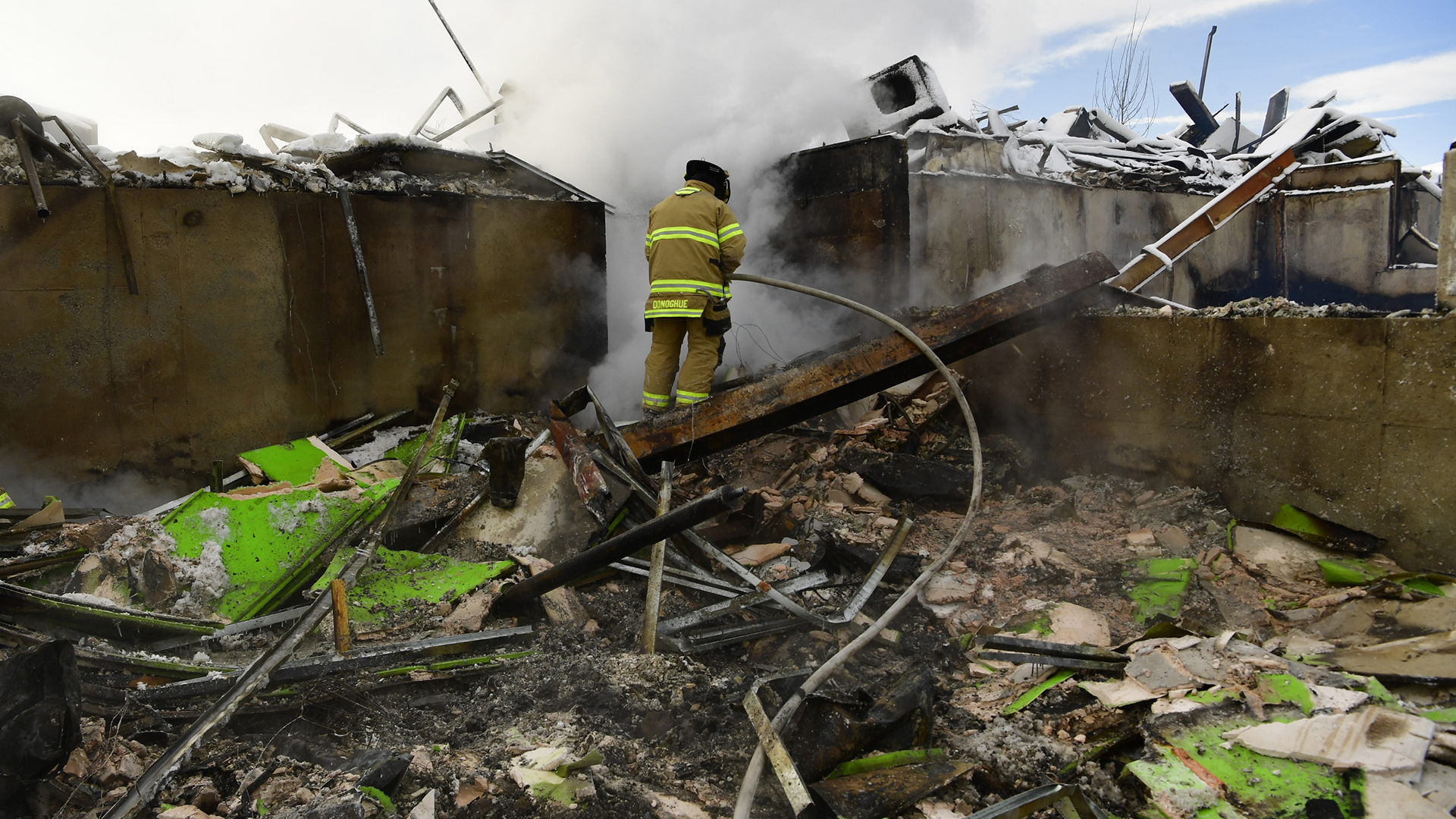On the 'doorstep of doom': Doomsday Clock stands at 100 seconds to midnight
The hypothetical clock's hands mark our nearness to annihilation.
Doomsday is as close today as it was yesterday, according to a hypothetical timepiece known as the Doomsday Clock; for the second year in a row, the clock's hands hover at 100 seconds to midnight — the hour of humanity's destruction.
However, it's still not too late to turn back the clock's hands and make the world safer for people worldwide, said "timekeepers" with the Bulletin of the Atomic Scientists (BAS). Representatives of the nonprofit announced the clock's new time on Thursday (Jan. 20), at a virtual press event, which you can watch on Live Science.
The past year included "several bright spots and many disturbing trends," including the alarming rise of online misinformation that curbed progress in mitigating the COVID-19 pandemic and hindered strategies for addressing climate change, BAS president and CEO Rachel Bronson said at the press event.
Related: End of the world? Top 10 doomsday threats
In 2020, the BAS moved the clock's hands to 100 seconds to midnight — the closest the clock's hands have come to doomsday in its 75-year history — and the hands stayed within the 2-minute-warning realm in 2021, Live Science previously reported.
The BAS introduced the Doomsday Clock in 1947 with a magazine cover illustration of a clock showing 7 seconds to midnight, to draw attention to the unprecedented danger posed by nuclear weapons. During the Cold War decades that followed, the U.S. and the Soviet Union, along with other nations, produced and stored hundreds of atomic weapons, and the clock's time jumped to 2 minutes to midnight in 1953 after the detonation of the first hydrogen bombs. Russia currently possesses more than 6,000 nuclear warheads; the U.S. has over 5,500, and there are hundreds more in the United Kingdom, China, France, Pakistan, India, Israel and North Korea, the Arms Control Association estimated in 2021.
BAS scientists and policy experts annually set a new time for the clock that reflects whether or not humanity is inching closer to armageddon. While 2021 brought some progress in confronting global risks, we still loiter on "the doorstep of doom," according to a BAS statement. Faced with dire threats of climate change and the COVID-19 pandemic, rampant misinformation and inconsistent responses by communities and leaders have severely hindered our progress in addressing both of those serious challenges, BAS representatives said at the press event.
Get the world’s most fascinating discoveries delivered straight to your inbox.
"We've proven in the last two years that big challenges don't necessarily bring us together," BAS presenter, science communicator and author Hank Green told Live Science.
What time is it?
When setting the Doomsday Clock each year, the BAS asks two important questions: "Is humanity safer or at greater risk this year compared to last year, and is humanity safer or at greater risk this year compared to the 75 years we've been asking the question, with a focus on man-made threats, nuclear risk, climate change and new disruptive technologies," Bronson said.
This past year did bring some positive developments in the management of nuclear weapons, with the U.S. and Russia resuming diplomatic dialogues about arsenal caps and maintaining nuclear stability, said Scott Sagan, BAS Science and Security Board member and a professor of political science at Stanford University in California.
But relations between the two nations remain tense; and with China and Russia testing new antisatellite weapons, North Korea producing new nuclear material and developing short-range missiles for atomic weapons, and nuclear stockpiling still underway in India and Pakistan, "the world faces multiple arms races without arms control," Sagan said at the briefing.
The Doomsday Clock's time also reflects the continued spread of the COVID-19 pandemic, which has killed approximately 5 million people worldwide, and an estimated 30 million deaths have gone unreported, BAS board member Asha George, executive director of the Bipartisan Commission on Biodefense, said at the briefing. The disease continues to spread and evolve in part because many global leaders failed to quickly and reliably enforce measures such as vaccination and mask-wearing, which would have dramatically slowed disease transmission, said BAS board member Suzet McKinney, principal and director of Life Sciences at Sterling Bay in Chicago.
"We've seen governments around the world recognize the true impact of their failure to respond appropriately: hundreds of millions of cases and the millions of deaths that we've seen as a result of this pandemic," McKinney told Live Science. "Here in the U.S., I believe the new administration is trying to turn the tide — but there was so much damage done in our initial response, I think it's proven very difficult." COVID-related disinformation also fueled the spread of the disease, leading people to reject scientifically proven methods for reducing transmission and crippling the authority of health officials to enforce mask-wearing and social distancing.
Climate disasters also dominated the news in 2021, with record-breaking heat waves, floods and wildfires. Proposals and actions to reduce fossil fuel use and replace them with sustainable energy infrastructure are falling far short of what would be necessary in order to reduce greenhouse gas emissions enough to prevent the worst-case scenarios predicted by climate models, according to the BAS statement.
"Each year that human activities continue to dump carbon dioxide into the atmosphere, it nearly irreversibly ratchets up the toll of human suffering and ecosystem destruction arising from global climate disruption," BAS board member Raymond Pierrehumbert, a professor of physics at the University of Oxford, said at the briefing.
While it isn't possible to turn back the clock on climate change or the COVID-19 pandemic, pushing back the hands of the Doomsday Clock is within our grasp, BAS board members said. Large-scale change addressing climate and pandemic response will require unified political efforts and global policy shifts — but that doesn't mean that individual actions don't count, Green added.
"If you can get curious about one problem and make it marginally easier to solve, or a little bit better, other people will be working on other problems," Green said. "For me, that might be 'How do we communicate better on the internet,' because that's my area of expertise, but it's going to be different for everybody," he explained. "Just because the action that you have doesn't fix everything doesn't mean that it's not part of fixing everything."
Find out more about the Doomsday Clock in a special episode of LIVE/science on Friday (Jan. 21) at 12 p.m. ET, featuring interviews with Hank Green and Suzet McKinney. The episode will stream here on the Live Science website, on YouTube and on Facebook.
Originally published on Live Science.

Mindy Weisberger is a science journalist and author of "Rise of the Zombie Bugs: The Surprising Science of Parasitic Mind-Control" (Hopkins Press). She formerly edited for Scholastic and was a channel editor and senior writer for Live Science. She has reported on general science, covering climate change, paleontology, biology and space. Mindy studied film at Columbia University; prior to LS, she produced, wrote and directed media for the American Museum of Natural History in NYC. Her videos about dinosaurs, astrophysics, biodiversity and evolution appear in museums and science centers worldwide, earning awards such as the CINE Golden Eagle and the Communicator Award of Excellence. Her writing has also appeared in Scientific American, The Washington Post, How It Works Magazine and CNN.



